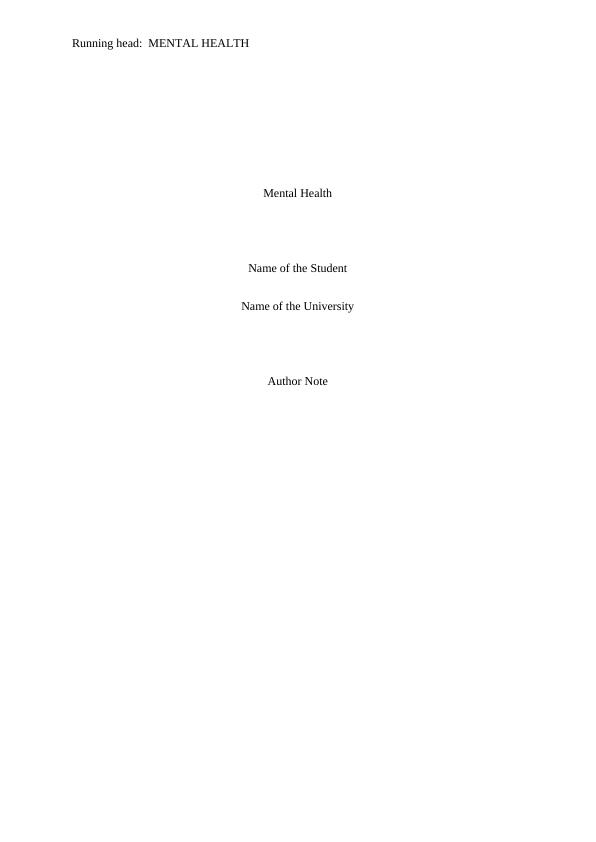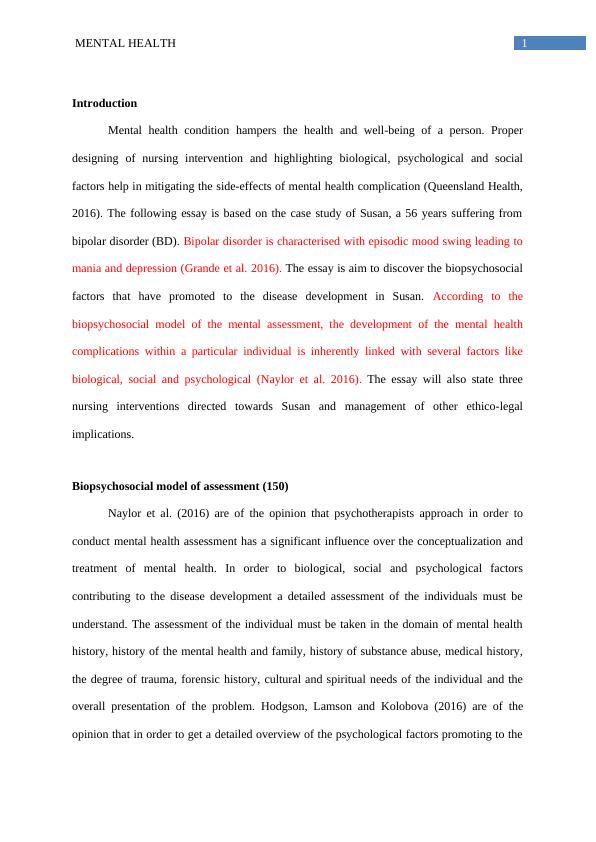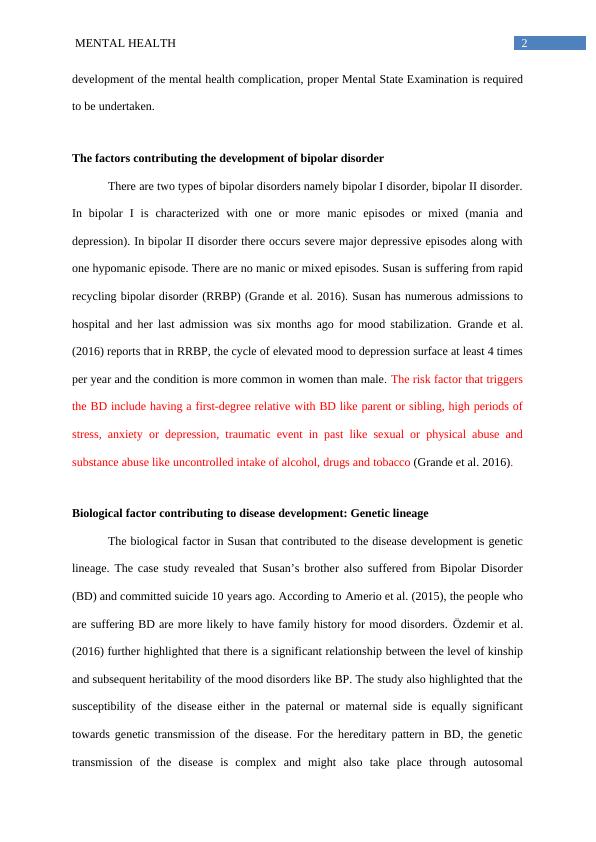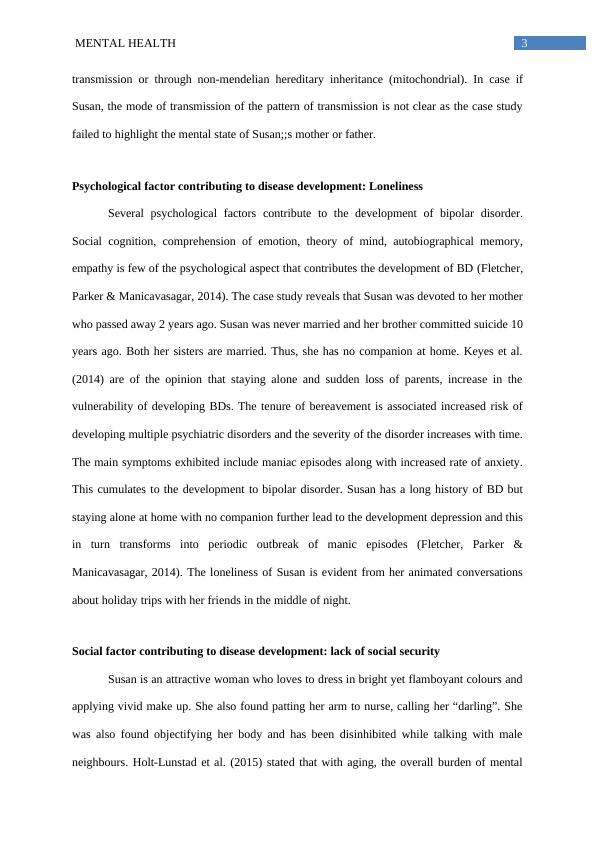Biopsychosocial Model of Mental Health Assessment 2022
Added on 2022-09-23
11 Pages2968 Words18 Views
Running head: MENTAL HEALTH
Mental Health
Name of the Student
Name of the University
Author Note
Mental Health
Name of the Student
Name of the University
Author Note

1MENTAL HEALTH
Introduction
Mental health condition hampers the health and well-being of a person. Proper
designing of nursing intervention and highlighting biological, psychological and social
factors help in mitigating the side-effects of mental health complication (Queensland Health,
2016). The following essay is based on the case study of Susan, a 56 years suffering from
bipolar disorder (BD). Bipolar disorder is characterised with episodic mood swing leading to
mania and depression (Grande et al. 2016). The essay is aim to discover the biopsychosocial
factors that have promoted to the disease development in Susan. According to the
biopsychosocial model of the mental assessment, the development of the mental health
complications within a particular individual is inherently linked with several factors like
biological, social and psychological (Naylor et al. 2016). The essay will also state three
nursing interventions directed towards Susan and management of other ethico-legal
implications.
Biopsychosocial model of assessment (150)
Naylor et al. (2016) are of the opinion that psychotherapists approach in order to
conduct mental health assessment has a significant influence over the conceptualization and
treatment of mental health. In order to biological, social and psychological factors
contributing to the disease development a detailed assessment of the individuals must be
understand. The assessment of the individual must be taken in the domain of mental health
history, history of the mental health and family, history of substance abuse, medical history,
the degree of trauma, forensic history, cultural and spiritual needs of the individual and the
overall presentation of the problem. Hodgson, Lamson and Kolobova (2016) are of the
opinion that in order to get a detailed overview of the psychological factors promoting to the
Introduction
Mental health condition hampers the health and well-being of a person. Proper
designing of nursing intervention and highlighting biological, psychological and social
factors help in mitigating the side-effects of mental health complication (Queensland Health,
2016). The following essay is based on the case study of Susan, a 56 years suffering from
bipolar disorder (BD). Bipolar disorder is characterised with episodic mood swing leading to
mania and depression (Grande et al. 2016). The essay is aim to discover the biopsychosocial
factors that have promoted to the disease development in Susan. According to the
biopsychosocial model of the mental assessment, the development of the mental health
complications within a particular individual is inherently linked with several factors like
biological, social and psychological (Naylor et al. 2016). The essay will also state three
nursing interventions directed towards Susan and management of other ethico-legal
implications.
Biopsychosocial model of assessment (150)
Naylor et al. (2016) are of the opinion that psychotherapists approach in order to
conduct mental health assessment has a significant influence over the conceptualization and
treatment of mental health. In order to biological, social and psychological factors
contributing to the disease development a detailed assessment of the individuals must be
understand. The assessment of the individual must be taken in the domain of mental health
history, history of the mental health and family, history of substance abuse, medical history,
the degree of trauma, forensic history, cultural and spiritual needs of the individual and the
overall presentation of the problem. Hodgson, Lamson and Kolobova (2016) are of the
opinion that in order to get a detailed overview of the psychological factors promoting to the

2MENTAL HEALTH
development of the mental health complication, proper Mental State Examination is required
to be undertaken.
The factors contributing the development of bipolar disorder
There are two types of bipolar disorders namely bipolar I disorder, bipolar II disorder.
In bipolar I is characterized with one or more manic episodes or mixed (mania and
depression). In bipolar II disorder there occurs severe major depressive episodes along with
one hypomanic episode. There are no manic or mixed episodes. Susan is suffering from rapid
recycling bipolar disorder (RRBP) (Grande et al. 2016). Susan has numerous admissions to
hospital and her last admission was six months ago for mood stabilization. Grande et al.
(2016) reports that in RRBP, the cycle of elevated mood to depression surface at least 4 times
per year and the condition is more common in women than male. The risk factor that triggers
the BD include having a first-degree relative with BD like parent or sibling, high periods of
stress, anxiety or depression, traumatic event in past like sexual or physical abuse and
substance abuse like uncontrolled intake of alcohol, drugs and tobacco (Grande et al. 2016).
Biological factor contributing to disease development: Genetic lineage
The biological factor in Susan that contributed to the disease development is genetic
lineage. The case study revealed that Susan’s brother also suffered from Bipolar Disorder
(BD) and committed suicide 10 years ago. According to Amerio et al. (2015), the people who
are suffering BD are more likely to have family history for mood disorders. Özdemir et al.
(2016) further highlighted that there is a significant relationship between the level of kinship
and subsequent heritability of the mood disorders like BP. The study also highlighted that the
susceptibility of the disease either in the paternal or maternal side is equally significant
towards genetic transmission of the disease. For the hereditary pattern in BD, the genetic
transmission of the disease is complex and might also take place through autosomal
development of the mental health complication, proper Mental State Examination is required
to be undertaken.
The factors contributing the development of bipolar disorder
There are two types of bipolar disorders namely bipolar I disorder, bipolar II disorder.
In bipolar I is characterized with one or more manic episodes or mixed (mania and
depression). In bipolar II disorder there occurs severe major depressive episodes along with
one hypomanic episode. There are no manic or mixed episodes. Susan is suffering from rapid
recycling bipolar disorder (RRBP) (Grande et al. 2016). Susan has numerous admissions to
hospital and her last admission was six months ago for mood stabilization. Grande et al.
(2016) reports that in RRBP, the cycle of elevated mood to depression surface at least 4 times
per year and the condition is more common in women than male. The risk factor that triggers
the BD include having a first-degree relative with BD like parent or sibling, high periods of
stress, anxiety or depression, traumatic event in past like sexual or physical abuse and
substance abuse like uncontrolled intake of alcohol, drugs and tobacco (Grande et al. 2016).
Biological factor contributing to disease development: Genetic lineage
The biological factor in Susan that contributed to the disease development is genetic
lineage. The case study revealed that Susan’s brother also suffered from Bipolar Disorder
(BD) and committed suicide 10 years ago. According to Amerio et al. (2015), the people who
are suffering BD are more likely to have family history for mood disorders. Özdemir et al.
(2016) further highlighted that there is a significant relationship between the level of kinship
and subsequent heritability of the mood disorders like BP. The study also highlighted that the
susceptibility of the disease either in the paternal or maternal side is equally significant
towards genetic transmission of the disease. For the hereditary pattern in BD, the genetic
transmission of the disease is complex and might also take place through autosomal

3MENTAL HEALTH
transmission or through non-mendelian hereditary inheritance (mitochondrial). In case if
Susan, the mode of transmission of the pattern of transmission is not clear as the case study
failed to highlight the mental state of Susan;;s mother or father.
Psychological factor contributing to disease development: Loneliness
Several psychological factors contribute to the development of bipolar disorder.
Social cognition, comprehension of emotion, theory of mind, autobiographical memory,
empathy is few of the psychological aspect that contributes the development of BD (Fletcher,
Parker & Manicavasagar, 2014). The case study reveals that Susan was devoted to her mother
who passed away 2 years ago. Susan was never married and her brother committed suicide 10
years ago. Both her sisters are married. Thus, she has no companion at home. Keyes et al.
(2014) are of the opinion that staying alone and sudden loss of parents, increase in the
vulnerability of developing BDs. The tenure of bereavement is associated increased risk of
developing multiple psychiatric disorders and the severity of the disorder increases with time.
The main symptoms exhibited include maniac episodes along with increased rate of anxiety.
This cumulates to the development to bipolar disorder. Susan has a long history of BD but
staying alone at home with no companion further lead to the development depression and this
in turn transforms into periodic outbreak of manic episodes (Fletcher, Parker &
Manicavasagar, 2014). The loneliness of Susan is evident from her animated conversations
about holiday trips with her friends in the middle of night.
Social factor contributing to disease development: lack of social security
Susan is an attractive woman who loves to dress in bright yet flamboyant colours and
applying vivid make up. She also found patting her arm to nurse, calling her “darling”. She
was also found objectifying her body and has been disinhibited while talking with male
neighbours. Holt-Lunstad et al. (2015) stated that with aging, the overall burden of mental
transmission or through non-mendelian hereditary inheritance (mitochondrial). In case if
Susan, the mode of transmission of the pattern of transmission is not clear as the case study
failed to highlight the mental state of Susan;;s mother or father.
Psychological factor contributing to disease development: Loneliness
Several psychological factors contribute to the development of bipolar disorder.
Social cognition, comprehension of emotion, theory of mind, autobiographical memory,
empathy is few of the psychological aspect that contributes the development of BD (Fletcher,
Parker & Manicavasagar, 2014). The case study reveals that Susan was devoted to her mother
who passed away 2 years ago. Susan was never married and her brother committed suicide 10
years ago. Both her sisters are married. Thus, she has no companion at home. Keyes et al.
(2014) are of the opinion that staying alone and sudden loss of parents, increase in the
vulnerability of developing BDs. The tenure of bereavement is associated increased risk of
developing multiple psychiatric disorders and the severity of the disorder increases with time.
The main symptoms exhibited include maniac episodes along with increased rate of anxiety.
This cumulates to the development to bipolar disorder. Susan has a long history of BD but
staying alone at home with no companion further lead to the development depression and this
in turn transforms into periodic outbreak of manic episodes (Fletcher, Parker &
Manicavasagar, 2014). The loneliness of Susan is evident from her animated conversations
about holiday trips with her friends in the middle of night.
Social factor contributing to disease development: lack of social security
Susan is an attractive woman who loves to dress in bright yet flamboyant colours and
applying vivid make up. She also found patting her arm to nurse, calling her “darling”. She
was also found objectifying her body and has been disinhibited while talking with male
neighbours. Holt-Lunstad et al. (2015) stated that with aging, the overall burden of mental

End of preview
Want to access all the pages? Upload your documents or become a member.
Related Documents
Psychology: Bipolar Disorderlg...
|8
|1520
|405
Mental Health FOPlg...
|5
|913
|247
BD 2 Running Head: BD 2 Bipolar Disorder February 29, 2020 [Company name]lg...
|15
|3927
|493
Mental Health: Care Options for Bipolar Disorder Patientlg...
|10
|3268
|73
Bipolar Disorder: Symptoms, Causes, Diagnosis, Treatment and Preventionlg...
|9
|1576
|172
Psychological Disorders and Treatmentlg...
|8
|1420
|193